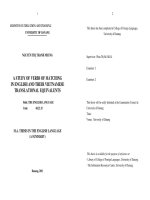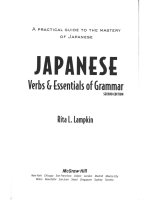Verbs of perception
Bạn đang xem bản rút gọn của tài liệu. Xem và tải ngay bản đầy đủ của tài liệu tại đây (8.44 KB, 1 trang )
Verbs of perception
Hear, see, watch, notice
and similar verbs of perception can be followed by
object + infinitive without to
or
object + -ing form.
There is usually a difference of meaning between the two structures.
The
infinitive
is used after these verbs when we want to say that we hear or see the whole of an action or event.
The
–ing form
is used to suggest that we hear an action or event in progress.
Compare:
I
heard
her
sing
a lovely song. (As I sat listening, she started singing a song and I listened to her until she
finished it.)
I
heard
her
singing
a song as I walked past her room. (When I heard her she was singing a song – she was
probably in the middle of her singing. Anyway, I didn’t hear the entire song.)
The
–ing form
can suggest repetition.
I
saw
him
throwing
stones at the dogs. (= He kept throwing stones.)
After these verbs possessive forms cannot be used with an
–ing form.
I saw
Peter getting
out of the train. (NOT I saw Peter’s getting out of the train.)
Object + past participle
The verbs
see, hear, watch, notice
etc., can also be followed by an
object + past participle
.
In this structure, the past participle has a passive meaning.
I
heard
my name
repeated
several times. (= My name was repeated several times.)
Look at
Look at
can be followed by
object + -ing form
. In American English, object + infinitive is also possible.
Look at him dancing!
Look at him dance! (US)
Be first to know when grammar rules change! Sign up to our newsletter here: englishgrammar.org (It's free)
Powered by TCPDF (www.tcpdf.org)









